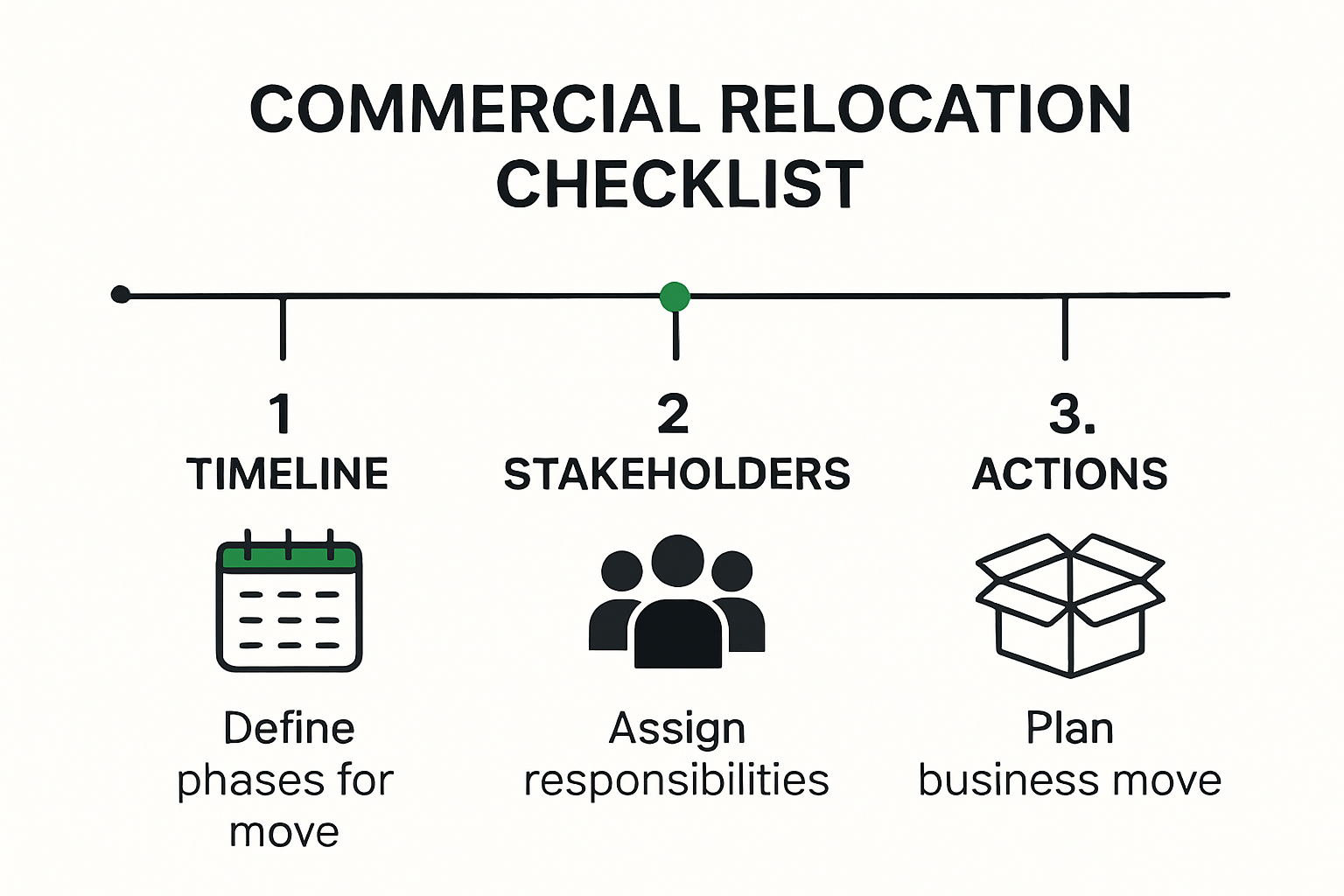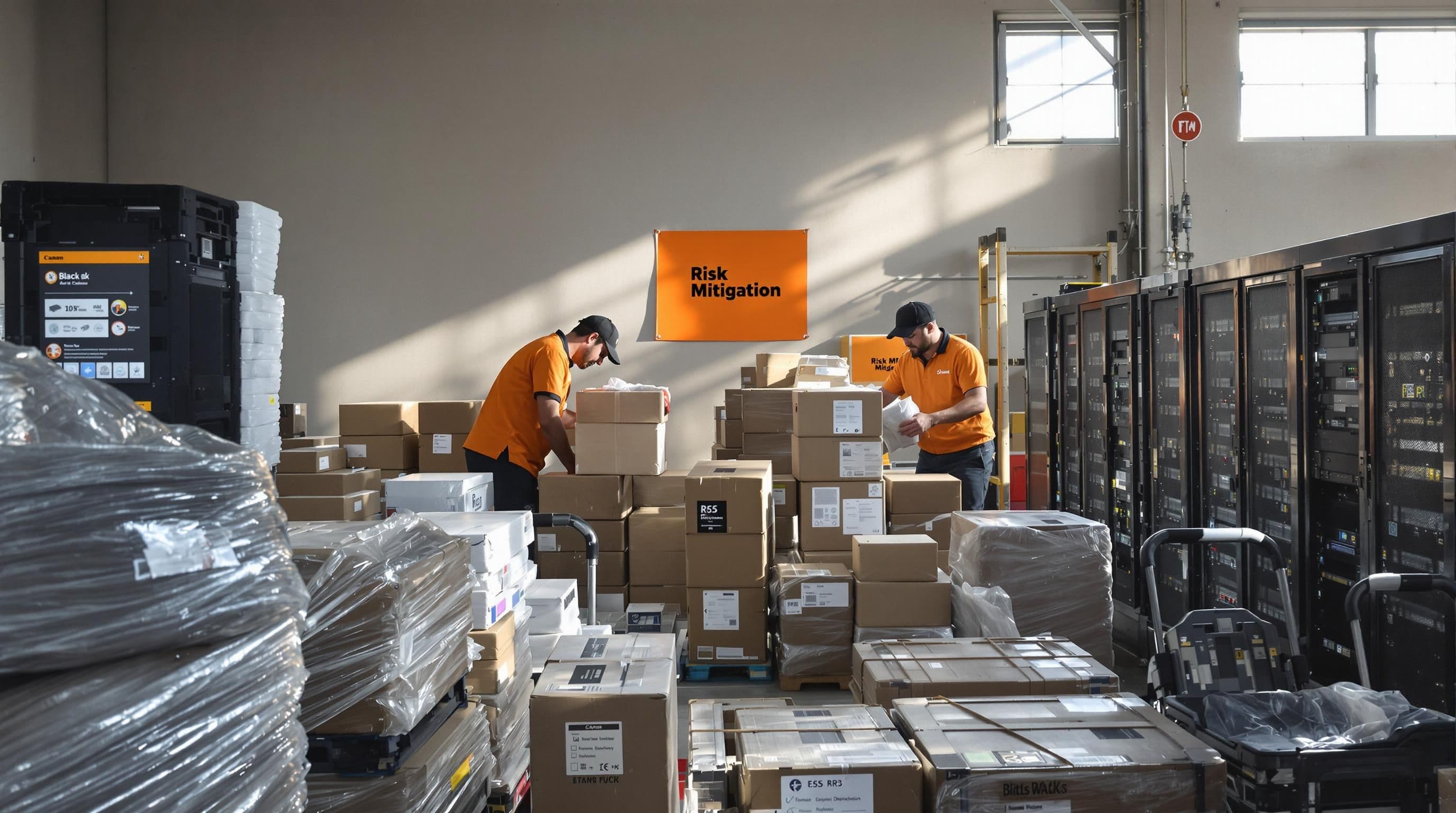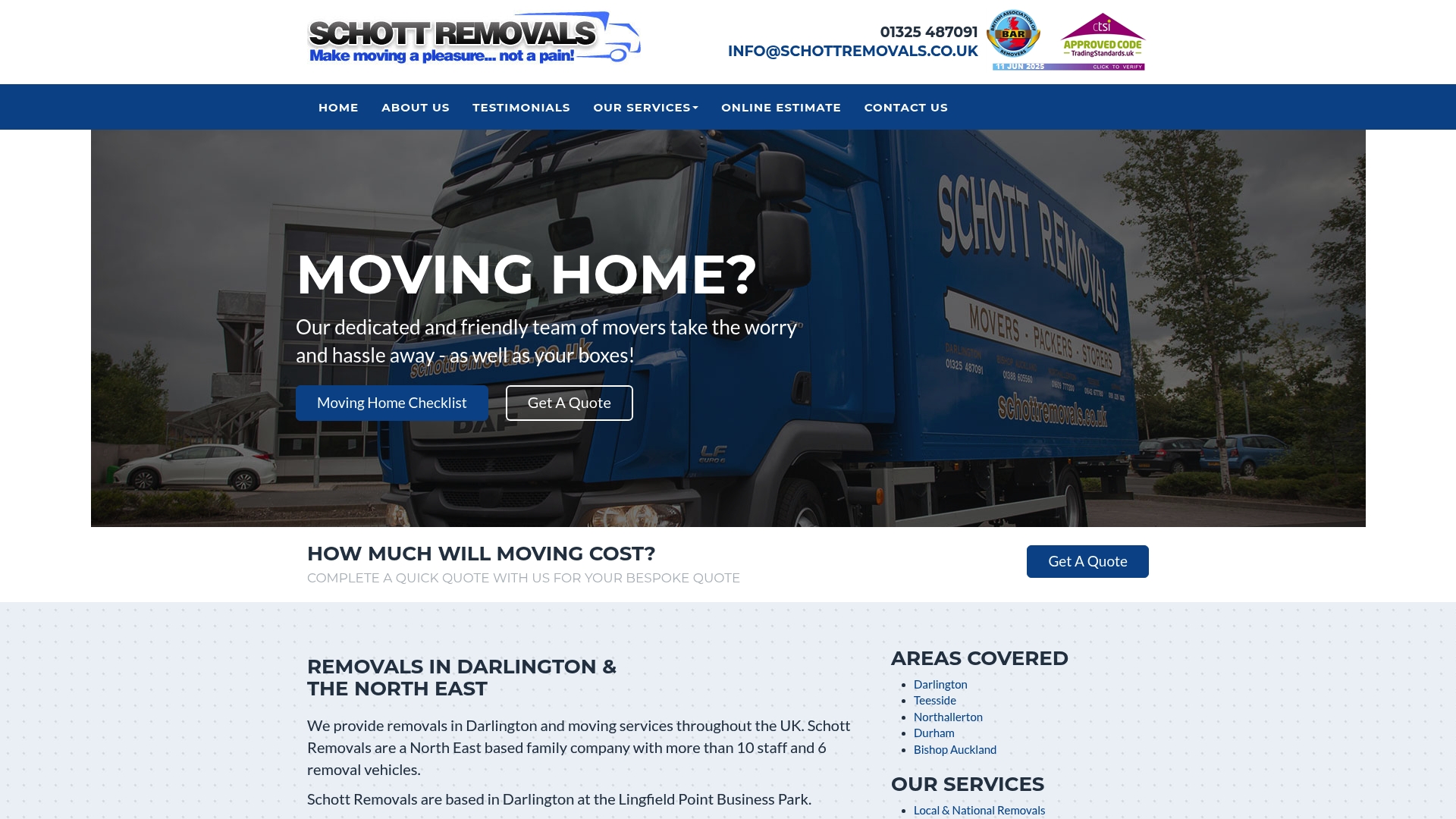Commercial moves across the UK are on the rise and companies are shifting focus as they chase growth or efficiency. Most expect headache-inducing chaos, mountains of paperwork and equipment at risk. But here is something to consider. Businesses that start planning at least six months ahead experience up to 50 percent fewer disruptions during their move. So an organised approach does more than reduce stress. It can actually turn moving day from a dreaded hurdle into a smooth leap forward.
| Takeaway | Explanation |
|---|---|
| Engage Professionals Early | Initiate your relocation planning at least six months in advance to ensure effective strategies and minimize disruptions. |
| Prioritize Risk Management | Conduct thorough risk assessments and adhere to safety regulations to safeguard assets during the move. |
| Verify Removal Company Credentials | Check the removal company’s experience, insurance, and references to ensure a reliable and professional service. |
| Strategize Packing for Sensitivity | Use specialized packing techniques for valuable items, focusing on protection and minimizing movement during transport. |
| Understand International Compliance Needs | Familiarize yourself with regulatory requirements, documentation, and storage regulations when relocating internationally. |

Commercial relocations represent complex logistical challenges that demand meticulous preparation and strategic thinking. Successful moves require comprehensive planning that goes far beyond simply transferring physical assets from one location to another.
Moving a business is not a simple task but a comprehensive operational transformation. Research from the Crown Commercial Service recommends engaging professional relocation services at least six months in advance. This timeline allows businesses to develop realistic budgets, create detailed transition strategies, and minimise potential disruptions to daily operations.
The planning phase involves multiple critical considerations. Companies must assess their current infrastructure, evaluate new workspace requirements, and develop a systematic approach to transferring equipment, technology systems, and personnel. Strategic planning includes comprehensive inventory management, understanding legal requirements, and creating contingency protocols for potential challenges.
According to Loughborough University’s Health and Safety Service, commercial relocations must prioritise risk assessments and safety protocols. Businesses need to:
Additionally, companies must consider technological infrastructure migration. This involves carefully planning the transfer of digital systems, ensuring minimal downtime, and protecting sensitive data during the transition. IT infrastructure mapping, backup strategies, and coordinated communication become paramount in maintaining operational continuity.
Budgetary planning represents another crucial aspect of commercial relocation. Beyond direct moving expenses, businesses must account for potential productivity losses, temporary operational disruptions, and potential equipment replacement or reconfiguration costs. The UK Government Property Strategy emphasises considering broader economic and social impacts when planning organisational moves.
Successful commercial relocations require a holistic approach that balances logistical efficiency with strategic vision. By investing time in comprehensive planning, businesses can transform what could be a challenging transition into an opportunity for operational enhancement and organisational growth.
Selecting the right removal company is a critical decision that can significantly impact the success and safety of your commercial relocation. The process demands careful evaluation, thorough research, and a comprehensive understanding of insurance and security requirements.
According to the UK government’s guidance, businesses must prioritize verifying a removal company’s professional credentials. This involves investigating their membership in recognized trade associations, checking their operational history, and confirming their insurance coverage.
Key factors to consider include the company’s years of experience in commercial relocations, their track record of successful moves, and testimonials from previous clients. Professional removal companies should be transparent about their operational processes, provide detailed documentation, and demonstrate a commitment to industry best practices.
Research from the Entrepreneur Handbook emphasizes the importance of comprehensive insurance coverage during commercial moves. Businesses should carefully review their existing insurance policies and understand what additional coverage might be necessary for the relocation process.
Critical insurance considerations include:
According to Law Donut, obtaining detailed quotes and understanding the specific terms of insurance coverage is crucial. Companies should request comprehensive documentation that outlines exactly what is covered, potential exclusions, and the claims process.
Beyond insurance, businesses must conduct comprehensive due diligence when selecting a removal company. This involves requesting and checking references, examining the company’s equipment and vehicles, and understanding their approach to handling complex commercial relocations.
Additional recommended steps include:
A methodical approach to selecting a removal company minimizes risks and ensures a smooth, secure transition. By prioritizing professional credentials, comprehensive insurance, and thorough planning, businesses can transform a potentially stressful relocation into a strategic and well-managed process.
To help readers quickly evaluate and compare the essential insurance coverages for commercial moves, the following table summarises key types, their purposes, and what they protect:
| Insurance Type | Purpose | What it Protects |
|---|---|---|
| Goods in Transit Coverage | Protection during equipment/asset transportation | Equipment, assets |
| Public Liability Insurance | Safeguards against accidents/damage during move | Business, third parties |
| Specialist Equipment Insurance | Ensures coverage for high-value/tech infrastructure | Sensitive technological assets |
Protecting valuable and sensitive items during commercial relocations requires a strategic and methodical approach. The complexity of safeguarding specialized equipment, technological infrastructure, and critical business assets demands expert planning and precise execution.
According to the University of California, Berkeley’s moving guidelines, effective packing involves more than simply placing items into boxes. Businesses must develop a comprehensive strategy that considers the unique characteristics of each asset, its fragility, and potential transportation risks.
Key considerations include categorizing items based on their sensitivity, value, and potential vulnerability. High-value technological equipment requires specialized packing materials that provide shock absorption, temperature regulation, and protection against potential moisture or static electricity. Professional movers recommend using custom-designed containers with reinforced padding, anti-static materials, and precise dimensions that minimise movement during transportation.
Harvard University’s Preservation Move Guidelines highlight the critical importance of systematic documentation and careful handling during relocation. Businesses should create detailed inventories that include:
Specialized handling protocols become essential when moving sensitive technological infrastructure. This includes using anti-static packaging, controlling environmental conditions during transit, and ensuring minimal physical disruption to delicate components.

Risk mitigation requires a multifaceted approach that goes beyond physical packaging. Companies must consider potential scenarios that could compromise equipment integrity, developing contingency plans for unexpected transportation challenges.
Recommended professional packing techniques include:
Below is a table summarising recommended packing techniques, the risks they address, and key benefits for commercial relocations:
| Technique | Risk Addressed | Key Benefit |
|---|---|---|
| Custom-engineered protective cases | Equipment damage during handling/transport | Reduced risk of physical damage |
| Temperature & humidity controlled transport | Climate-related equipment degradation | Maintains asset condition |
| Professional packers for tech assets | Improper handling of high-value equipment | Maximises asset safety and compliance |
| Anti-static packaging and protocols | Static discharge damage | Protects sensitive circuitry/components |
Successful commercial relocations demand a holistic approach to protecting valuable assets. By combining meticulous planning, specialized packing techniques, and comprehensive risk management, businesses can ensure their critical infrastructure remains secure and functional throughout the moving process.
Careful preparation transforms what could be a high-risk endeavour into a controlled, systematic transition that safeguards a company’s most valuable technological resources.
International commercial relocations and complex storage requirements demand meticulous planning and comprehensive understanding of regulatory frameworks. Businesses must navigate intricate logistical challenges while ensuring compliance with multiple jurisdictional requirements.
According to Wolters Kluwer’s business relocation guidelines, companies must prioritize systematic address updates and regulatory compliance. This involves notifying government agencies, updating official registrations, and maintaining accurate documentation throughout the relocation process.
Key documentation requirements include:
Businesses must also prepare comprehensive inventories of items being relocated or stored, ensuring transparency and facilitating smooth customs clearance processes.
The UK Government’s guidance on temporary storage highlights critical considerations for businesses requiring international moving or storage solutions. Companies must establish robust systems for tracking and managing assets during transition.
Critical international shipping considerations include:
The UK Department for Business and Trade emphasizes the importance of understanding specific trade regulations, including UK Global Tariff requirements and potential import controls that might impact business relocations.
Effective international moves require sophisticated storage strategies that go beyond simple physical preservation. Businesses must develop comprehensive asset management protocols that address:
Successful international relocations and storage management demand a holistic approach that combines regulatory compliance, strategic planning, and adaptable logistics. By developing comprehensive checklists and maintaining meticulous documentation, businesses can transform complex international moves into seamless operational transitions.
Careful preparation, proactive communication, and strategic asset management become the cornerstone of successful international commercial relocations.
Businesses should start planning their commercial relocation at least six months in advance. This allows for the development of effective strategies and minimises disruptions during the move.
To ensure compliance, businesses need to prioritize risk assessments, adhere to health and safety regulations, and maintain accurate documentation throughout the relocation process.
When selecting a removal company, businesses should verify their credentials, assess their insurance coverage, check client references, and evaluate their experience in handling commercial relocations.
Best practices for packing valuable and sensitive items include using custom-designed containers for protection, categorising items based on their fragility, and employing professional packing techniques to minimise movement during transport.
Worried about the stress of relocating your business? As the article highlighted, commercial moves often involve paperwork overload, strict timelines, and the high risk of equipment damage. You deserve a process that is both smooth and secure. At Schott Removals, we specialise in commercial relocations across the UK, taking away uncertainty through careful planning, clear risk management and detailed packing strategies. Our team understands the disruption a poorly managed move can cause and brings the expertise you need to avoid these pitfalls.

Do not leave your business at risk. Trust a family-run company with more than 30 years of experience delivering professional, insured and efficient relocations. Visit Schott Removals now to arrange your free quotation and start planning a seamless transition. Secure your business assets and future by contacting us today.
Unit 20, Lingfield Point
McMullen Road,
Darlington
DL1 1RW
Telephone: 01325 487091
Email: info@schottremovals.co.uk